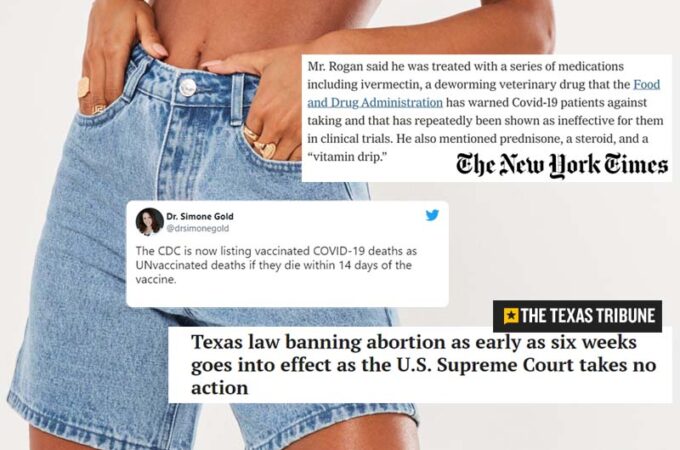Now you can listen to this article on The PonkaBlog Podcast!
Today, instead of one longer article, I’m going to touch on three topics that weren’t big enough for me to cover individually.
The New York Times, Joe Rogan and Ivermectin
As you may know, Joe Rogan announced this week that he’s contracted COVID-19. The New York Times reported that he’s being treated with “Ivermectin, a deworming veterinary drug that the FDA has warned COVID-19 patients against taking and that has repeatedly been shown as ineffective for them in clinical trials”.
Technically, it’s true that Ivermectin is used in veterinary medicine, many drugs developed for humans are. But saying that Ivermectin is used as a deworming veterinary drug is like saying that penicillin is used to fight off infections in horses. Both are true, but clearly not the whole story.
Ivermectin has been used by billions of humans for a variety of purposes, including use as an antiparasitic. It’s proven itself to be safe, effective and relatively free of side effects.
Now, as for its effectiveness against COVID-19…
Over the past few months, there have been real-world studies in India, Mexico and Peru that indicate Ivermectin is highly effective at preventing COVID-19 and treating people who have already contracted the disease. In some studies, Ivermectin is as effective as the vackseens. With none of the side effects.
I would rate the Times article as “mostly false” or “lacking context”. Screw that, let’s call it what it is: “purposely misleading”.
Definition of “Fully Vacksinated”
There’s a story being shared about how COVID deaths are being counted as “unvacksinated” until 14 days after the second injection. They’ve claimed all along that whatever help the vackseen is going to provide won’t be maximized until two weeks after the second shot. This has always been their line in the sand.
The problem is that counting “partially vacksinated” as “unvacksinated” destroys our ability to track a control group of for-real-unvacksinated people. Once the data is mixed, we lose the ability to make comparisons between vacksinated, partially-vacksinated and unvacksinated.
If, as suspected, the vackseens are inhibiting a person’s ability to fight the disease on their own, we need to keep the data for the unvacksinated control group pristine and not combine it with people who have been chemically altered by any of the vackseens.
Now that they’ve started rolling out booster shots, it gets even more complicated. Now we’ll have yet another category. Let’s call them “booster hesitant”. We can’t call them “unvacksinated”, and we can’t call them “partially-vacksinated”. Because doing so wouldn’t be accurate.
To do things correctly, we’d need at least four groups: “Partially-vacksinated” would refer to people who are haven’t or won’t receive their second initial dose. “Fully-vacksinated” would refer to people who have taken all of the vackseens, and all of the boosters. “Booster-hesitant” would refer to people who had the original doses but haven’t or won’t take a booster shot. Finally, “unvacksinated” should only refer to people who haven’t been injected with any of the vackseens.
Ideally, we’d group people by the type of vackseens they’ve been injected with which would allow effectiveness rates to be compared for each product and for natural immunity. And, we’d need to track people who weren’t initially booster-hesitant but became so later. For example, someone might have taken the first booster shot but decline to take any subsequent ones.
So, instead of two groups to track, vacksinated and unvacksinated, we could actually end up with dozens or hundreds of groups and the necessity to track each one separately.
This will get incredibly complicated. But tracking the data in this way must happen if we’re truly going to be able to understand the effectiveness of the vackseens, and any damage caused by them.
Texas Abortion Ruling
A new law went into effect in Texas that bans abortions after a heartbeat is detected. Or, about six weeks after conception.
Pro-life people are going to take this as a win. But it’s actually a win for Big Pharma. The ruling doesn’t mean that people are going to have less sex. Nor does it mean that there will be less conceptions. What it does mean is that the “Morning After” pill is going to one of the best-selling drugs in Texas.
Available in Texas without a prescription, I predict we’ll see sales of the drug skyrocket as it becomes one of the few remaining options for terminating unwanted pregnancies. Young women are going to start eating these things like candy, and profits for Big Pharma will go through the roof.
Ands that wraps up our three Friday Shorts. I hope you found them interesting and informative.
You can listen to The PonkaBlog Podcast at PonkaBlog.com and on Apple Podcasts, Spotify and Amazon Music, Rumble and Stitcher. Just search for PonkaBlog wherever you get your podcasts and subscribe today!
Did you know I write a new article several times a week? I’ve started getting noticed by social media. Which, as you know, for a Conservative is never a good thing. I highly recommend you sign up for my newsletter. That way you won’t miss anything the next time social media censors what I write.


